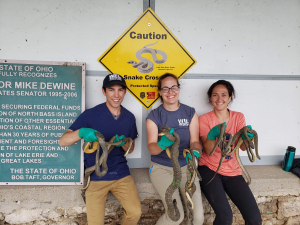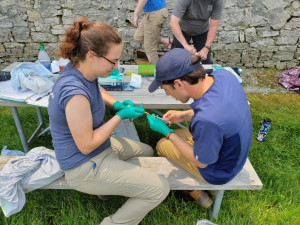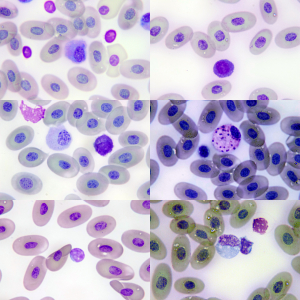Lake Erie watersnakes (LEWS)
 Lake Erie watersnakes (Nerodia sipedon insularum, LEWS) are a subspecies of the Northern watersnake confined to a group of islands in western Lake Erie. The species was listed as threatened under the U.S. Endangered Species Act in 1999 and delisted in 2011, with population recovery largely attributed to enormous public education, population monitoring, and habitat preservation efforts. Ophidiomycosis was first diagnosed in LEWS during a large die-off event in 2009 and skin lesions have been observed regularly during annual population surveys, thus representing a persistent threat to the health of these snakes.
Lake Erie watersnakes (Nerodia sipedon insularum, LEWS) are a subspecies of the Northern watersnake confined to a group of islands in western Lake Erie. The species was listed as threatened under the U.S. Endangered Species Act in 1999 and delisted in 2011, with population recovery largely attributed to enormous public education, population monitoring, and habitat preservation efforts. Ophidiomycosis was first diagnosed in LEWS during a large die-off event in 2009 and skin lesions have been observed regularly during annual population surveys, thus representing a persistent threat to the health of these snakes.
Yearly monitoring of LEWS population size and demography has been conducted at numerous sites since 1996 and represents one of the largest wildlife mark-recapture projects in the world. Each previously captured snake has a PIT tag with a unique ID that is matched to ongoing data collection about size and health status, so this population represents a unique opportunity to measure the impacts of disease at both the individual and population levels over multiple years. Previous studies have found a high prevalence of ophidiomycosis in other species of watersnakes, so studying this disease in LEWS may provide clues as to why the Nerodia genus differs from other groups of snakes.
 Long term monitoring projects at multiple sites enhance our understanding of both population and disease dynamics. Prevalence of ophidiomycosis may vary over time due to the impacts of yearly rainfall and temperature on fungal growth and disease transmission, as O. ophiodiicola growth and survival varies with soil hydration, temperature, and pH. In addition, if transmission levels are high, but disease rarely results in mortality, prevalence will increase over time. Spatial differences in disease prevalence may be due to different levels of human-induced landscape change, which has been found to have varied effects on wildlife disease prevalence. LEWS population surveys are conducted at sites on islands with varying human disturbance: some islands have high levels of motor vehicle traffic and seasonal visitors, while others have smaller numbers of permanent residents, and a few have no roads and only summer residents. Studying differences in disease prevalence across space and time may give us clues to the impacts of these factors on ophidiomycosis and suggest areas for further study.
Long term monitoring projects at multiple sites enhance our understanding of both population and disease dynamics. Prevalence of ophidiomycosis may vary over time due to the impacts of yearly rainfall and temperature on fungal growth and disease transmission, as O. ophiodiicola growth and survival varies with soil hydration, temperature, and pH. In addition, if transmission levels are high, but disease rarely results in mortality, prevalence will increase over time. Spatial differences in disease prevalence may be due to different levels of human-induced landscape change, which has been found to have varied effects on wildlife disease prevalence. LEWS population surveys are conducted at sites on islands with varying human disturbance: some islands have high levels of motor vehicle traffic and seasonal visitors, while others have smaller numbers of permanent residents, and a few have no roads and only summer residents. Studying differences in disease prevalence across space and time may give us clues to the impacts of these factors on ophidiomycosis and suggest areas for further study.
The Wildlife Epidemiology Lab has been working with Ohio State University’s Stone Lab to measure the prevalence of ophidiomycosis in LEWS since 2017. During the annual population surveys, we conduct physical exams to detect skin lesions and swab snakes to detect the DNA of the fungus that causes ophidiomycosis, Ophidiomyces ophiodiicola. Initial findings indicate that disease prevalence varies significantly between sites and over time; this work is ongoing.
 Our work with LEWS has also allowed for numerous projects related to ophidiomycosis, including evaluating the role of field capture methods in disease transmission, investigating the use of ultraviolet light as a diagnostic tool, comparing hematology values between snakes with and without ophidiomycosis, and measuring innate immune function. Finally, we have been fortunate to use wild-caught LEWS in a 2-year controlled clinical trial evaluating the use of terbinafine nebulization to treat snakes with ophidiomycosis. In all of these ways, LEWS have made a valuable contribution to our understanding and management of this emerging threat to snake health.
Our work with LEWS has also allowed for numerous projects related to ophidiomycosis, including evaluating the role of field capture methods in disease transmission, investigating the use of ultraviolet light as a diagnostic tool, comparing hematology values between snakes with and without ophidiomycosis, and measuring innate immune function. Finally, we have been fortunate to use wild-caught LEWS in a 2-year controlled clinical trial evaluating the use of terbinafine nebulization to treat snakes with ophidiomycosis. In all of these ways, LEWS have made a valuable contribution to our understanding and management of this emerging threat to snake health.
